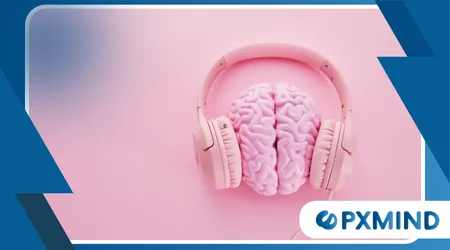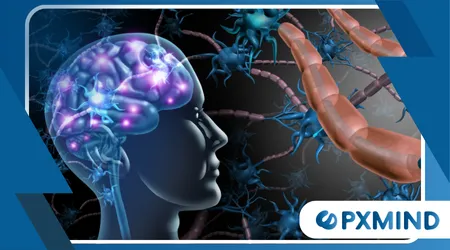La risposta del cervello alla musica: cosa rivela la ricerca

La risposta del cervello alla musica è un argomento di profondo fascino, che rivela come il suono possa plasmare le nostre menti.
Annunci
Oltre al semplice intrattenimento, il nostro cervello interagisce con melodie, armonie e ritmi in modi complessi e misurabili.
Questa intricata relazione tra input uditivo e attività neurale racconta una storia più profonda.
Cosa succede quando una canzone familiare ci inonda le orecchie, suscitando ricordi ed emozioni? Non si tratta solo di un'esperienza soggettiva, ma di una cascata di eventi biologici.
Il cervello elabora le informazioni musicali attraverso una rete di regioni specializzate. La corteccia uditiva, ad esempio, è la prima tappa per la conversione delle onde sonore in segnali elettrici.
Da lì, queste informazioni viaggiano verso aree associate alle emozioni, alla memoria e al controllo motorio. È un allenamento completo per il cervello, che coinvolge sia le funzioni primitive che quelle di ordine superiore.
L'intricata danza tra queste regioni è ciò che rende la musica un linguaggio universale.
La chimica dietro la melodia
Ascoltare una canzone amata innesca un rilascio di dopamina nei centri di ricompensa del cervello.
Questo neurotrasmettitore, spesso associato al piacere e alla motivazione, crea sensazioni di felicità e benessere.
Ecco perché una bella canzone può dare così tanto piacere. L'attesa di un pezzo preferito di una canzone rilascia anche dopamina.
Questo effetto è simile alla risposta del cervello al cibo o all'interazione sociale. È un potente meccanismo di feedback neurochimico.
Il cervello impara ad associare suoni specifici al piacere.
Questo aiuta a spiegare perché cerchiamo determinate canzoni o generi. Più ascoltiamo, più questi percorsi neurali diventano forti.
La musica può anche regolare cortisolo, l'ormone dello stress. Uno studio sulla rivista Tendenze nelle scienze cognitive hanno scoperto che la musica può abbassare i livelli di cortisolo, riducendo lo stress.
Per saperne di più: Come il cervello crea (e distrugge) le abitudini
Ciò supporta l'uso terapeutico della musica in ambito clinico. Il ritmo e la melodia agiscono come una forma di terapia non invasiva.
Musica e memoria: un legame indissolubile
Musica e memoria sono profondamente intrecciate, poiché le canzoni spesso evocano vividi ricordi.
Questo perché la musica attiva il ippocampo, un'area cerebrale fondamentale per la formazione della memoria. Una canzone della nostra giovinezza può trasportarci indietro nel tempo con sorprendente chiarezza.
Questo fenomeno è noto come effetto proustiano, applicato alla musica.
Per molti, questa connessione è automatica e profonda. Immagina di ascoltare una canzone del ballo di fine anno del tuo liceo.
All'improvviso potresti ricordare il luogo, l'abito o persino l'odore dell'aria notturna.
Non si tratta di un semplice ricordo; è un'esperienza multisensoriale innescata dal suono. Il cervello immagazzina insieme ricordi musicali ed emotivi.
Guarda quanto è interessante: Il legame tra nutrizione e salute mentale
La potenza di questo legame è così forte che viene utilizzato nelle terapie per patologie come la demenza.
Anche quando altri ricordi svaniscono, i ricordi musicali spesso rimangono intatti. La risposta del cervello alla musica in questo contesto offre una finestra unica sulla resilienza cognitiva.

Un racconto di due emisferi
Gli emisferi del cervello svolgono ruoli distinti nell'elaborazione della musica.
Mentre l'emisfero sinistro gestisce generalmente l'intonazione e il ritmo, l'emisfero destro è maggiormente coinvolto nella melodia e nel tono emotivo. Tuttavia, non si tratta di una divisione netta.
L'elaborazione musicale è un'attività altamente integrata.
Entrambi gli emisferi lavorano insieme per interpretare brani complessi. Ad esempio, un musicista potrebbe usare l'emisfero sinistro per l'analisi tecnica di uno spartito.
Allo stesso tempo, il loro emisfero destro li aiuta a percepire il peso emotivo del brano. Questa è la bellezza dell'approccio olistico del nostro cervello alla musica.
L'equilibrio tra elaborazione analitica ed emotiva è ciò che rende l'ascolto così ricco.
Leggi qui: Paga i debiti, investi nel tuo futuro e realizza i tuoi sogni
La plasticità del cervello gli consente di adattarsi all'apprendimento musicale. Il cervello di un musicista esperto mostra cambiamenti strutturali e funzionali.
Questi cambiamenti sono visibili nelle scansioni cerebrali, a dimostrazione di come il nostro cervello venga costantemente plasmato dall'ambiente circostante.
La risposta del cervello alla musica in azione
Immagina di camminare in un parco in una giornata di sole. Una dolce melodia acustica inizia a risuonare nelle tue cuffie.
Il tuo respiro rallenta, le tue spalle si abbassano e una sensazione di calma ti pervade.
Questo è un esempio dell'impatto diretto della musica sul sistema nervoso autonomo. Il cervello segnala al corpo di rilassarsi.
Ora immagina di essere in palestra. Un potente e ritmato inno rock risuona dagli altoparlanti.
Senti un'ondata di energia, il tuo battito cardiaco aumenta e ti alleni con rinnovato vigore. È un percorso neurale diverso in atto.
Il ritmo e il tempo ad alta energia stimolano la corteccia motoria del cervello.
Questi due esempi dimostrano come la musica possa influenzare il nostro stato fisiologico. Può avere un effetto sedativo o stimolante.
La scelta della musica che ascoltiamo non è solo una questione di gusti; è una forma di autoregolamentazione.
Scegliamo istintivamente la musica che più si adatta al nostro stato d'animo. Quanto è incredibile che una serie di onde sonore possa avere un effetto così profondo?
L'orchestra della comunicazione neurale La risposta del cervello alla musica
I neuroscienziati hanno individuato specifiche reti cerebrali che si attivano quando ascoltiamo la musica.
IL sistema limbico, compresa l'amigdala, è fondamentale per l'elaborazione delle risposte emotive.
Nel frattempo, il nucleo accumbens, parte del sistema di ricompensa, guida le nostre sensazioni di piacere.
Per molte persone, l'aspetto più interessante di questa ricerca è il suo potenziale di migliorare il benessere.
La musicoterapia viene utilizzata per vari disturbi, dall'ansia al morbo di Parkinson. L'applicazione terapeutica della musica è un campo in crescita.
Secondo uno studio del 2017 condotto dall' Università della Florida Centrale, i partecipanti che hanno ascoltato un podcast di 30 minuti con musica strumentale hanno segnalato una significativa diminuzione dei livelli di ansia rispetto a coloro che hanno ascoltato un podcast parlato.
Questa scoperta sottolinea il potere della musica non lirica di indurre uno stato di rilassamento e calma mentale, evidenziando ulteriormente La risposta del cervello alla musica come strumento terapeutico.

| Regione del cervello | Funzione nell'elaborazione musicale |
| Corteccia uditiva | Elaborazione iniziale dell'altezza e del ritmo del suono |
| Ippocampo | Associazione di memoria e ricordo |
| Nucleo accumbens | Rilascio di dopamina, piacere e ricompensa |
| Amigdala | Elaborazione emotiva, in particolare paura e gioia |
| Cervelletto | Tempismo, coordinazione motoria e regolazione emotiva |
La risposta del cervello alla musica
La risposta del cervello alla musica è un campo di studio affascinante. Rivela una profonda connessione biologica tra il suono e la nostra coscienza.
Dal rilascio di dopamina al risveglio di ricordi perduti da tempo, la musica è una vera e propria manipolatrice della nostra mente. Può calmarci, darci energia e trasportarci.
Comprendere questa complessa relazione offre nuove strade alla terapia e alla crescita personale.
La prossima volta che ascolti una canzone, ricorda che non stai solo ascoltando: stai orchestrando una sinfonia complessa e meravigliosa nella tua mente.
Domande frequenti sulla risposta del cervello alla musica
Ascoltare musica ti rende più intelligente?
Sebbene la ricerca dimostri che l'allenamento musicale può migliorare le capacità cognitive, il semplice ascolto della musica non aumenta automaticamente il QI.
Tuttavia, può migliorare la concentrazione, ridurre lo stress e influire positivamente sull'umore, supportando indirettamente le funzioni cognitive.
La musica può aiutare a gestire il dolore?
Sì, diversi studi hanno dimostrato che ascoltare musica può aiutare a ridurre la percezione del dolore.
Agisce distraendo la mente e stimolando il rilascio di endorfine, antidolorifici naturali.
++ Come la musica ti cambia la mente
++ La musica stimola l'attenzione del cervello, secondo uno studio di Stanford
